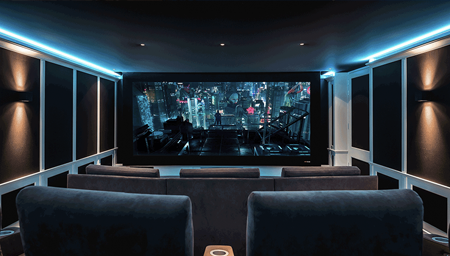
The 75-Inch Revolution
Most people now have access to affordable reference-quality gear—but do they know what to do with it?
by Michael Gaughn
May 28, 2021
I’m going to mention some things here that are probably pretty obvious to anyone who hasn’t spent the past couple of years wandering the Himalayas with their sherpa. My aim is to try provide a context that suggests that the world of home entertainment has recently changed in ways that go beyond the unbridled crowing of even the most gung-ho marketing hype.
No matter where you live, it’s impossible to ignore that the new entry level for TVs is 75 inches. Even if that screen size is way too big for many people’s homes, it’s still the size they hunger for. And sets like that have become readily affordable, making 42-inch sets seem as quaint as 19-inch screens seemed at the dawn of the HDTV era.
Here’s the more important point: Many of these models can provide reference-quality image reproduction, even toward the lower end of the price spectrum. This has never happened before. We are rapidly reaching a point where a good chunk of the American populace has sets that can provide a better-than-movie-theater experience at home. And with relative ease. And for a relatively small investment.
But . . .
Just because somebody’s set is capable of that kind of performance doesn’t mean they have it set up to take advantage of that ability, or even knows their set can do that. And it doesn’t mean they have it properly placed in the room or even have it in an appropriate room—chances are, they don’t. It also doesn’t necessarily mean the rest of their system is up to snuff—again, it probably isn’t.
But the one thing that’s more than likely true is that they also have at least one signal source that’s capable of besting their local movie theater. That has also never happened before. Streaming delivery is reaching the point where only highly trained viewers can see any compromises with reference-quality playback. And even that gap is closing rapidly.
So, an unprecedented number of people now have displays that can beat the previous gold standard of the movie theater. And an unprecedented number now have access to content delivery that also exceeds that standard. Again, that doesn’t mean they have their systems set up to take advantage of that but the potential is there nonetheless.
So what does this all mean, and what does it portend?
First off, to take aim squarely at the gorilla in the room: Why the hell do we continue to think we need movie theaters? If your system can do it better, and you don’t have to drive there, and your investment in an evening of movie-watching doesn’t have to hover near $100 (at a minimum), and first-run content is showing up day & date on streaming, and you don’t have to watch ads if you don’t want to, and you can instantly switch to another film if your first choice sucks, and you’ve got the option of banishing anybody who talks during the film, why would you think of theaters as anything other than the quaint, and mostly unpleasant, relics they are?
Second, it can only get better from here. As more people become aware of what their systems can do, it can only lead to better viewing environments, better gear for those environments, and even better content being pumped into those environments. If there’s a downside to any of this, I’m not seeing it. (The whole “movies have to be a communal experience” argument is usually promulgated by Hollywood types who haven’t sullied themselves with The Great Unwashed in years, if ever.)
But just because reference quality has gone mass market doesn’t mean there’s nothing left for the luxury market to aspire to. The list is long, but just to tick off a few things: Video walls will remain hugely expensive for the foreseeable future, but represent all but unexplored territory in the home environment. It takes a custom-designed, -built, and -tuned room to consistently have a reference-quality experience. Nobody’s figured out how to commodify that, and chances are no one ever will. And good luck trying to integrate a full-blown Atmos system into a typical middle American living room without having it look like a CIA black site.
You get the point. It’s great that better-than-movie-theater is becoming as common as Kleenex. But not all rooms or systems—or viewers—are created equal.
Michael Gaughn—The Absolute Sound, The Perfect Vision, Wideband, Stereo Review, Sound & Vision, The Rayva Roundtable, marketing, product design, some theater designs, a couple TV shows, some commercials, and now this.
© 2025 Cineluxe LLC





